Water Quality Project Analysis: Cost-Benefit Analysis and Policy
VerifiedAdded on 2023/01/16
|7
|1509
|24
Project
AI Summary
This project analyzes the cost-benefit of a water quality project focusing on a sewage plant upgrade. It begins by calculating the net present value (NPV), benefit-cost ratio, and internal rate of return (IRR) to determine whether to accept or reject the project. The analysis compares scenarios with an...
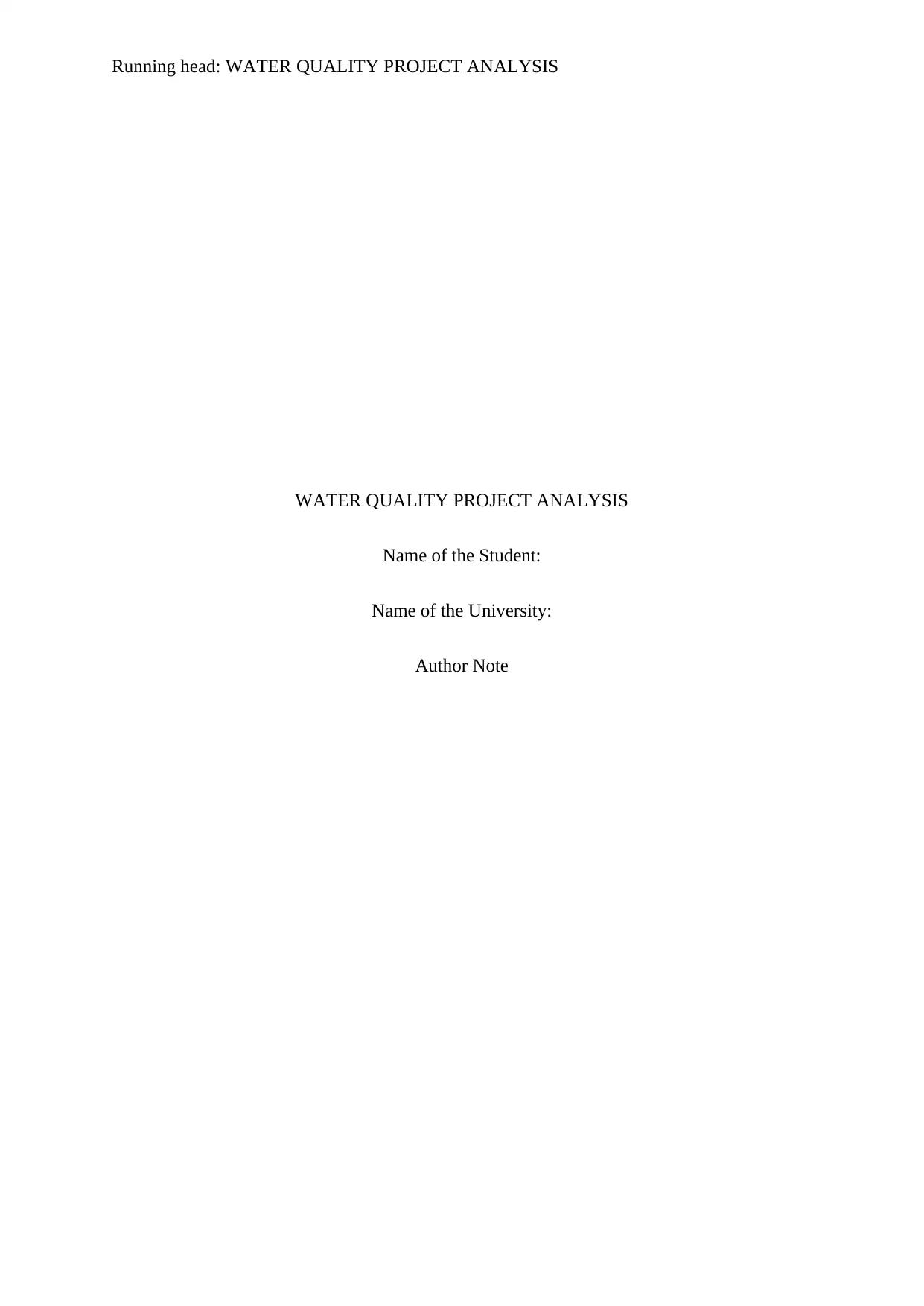
Running head: WATER QUALITY PROJECT ANALYSIS
WATER QUALITY PROJECT ANALYSIS
Name of the Student:
Name of the University:
Author Note
WATER QUALITY PROJECT ANALYSIS
Name of the Student:
Name of the University:
Author Note
Paraphrase This Document
Need a fresh take? Get an instant paraphrase of this document with our AI Paraphraser
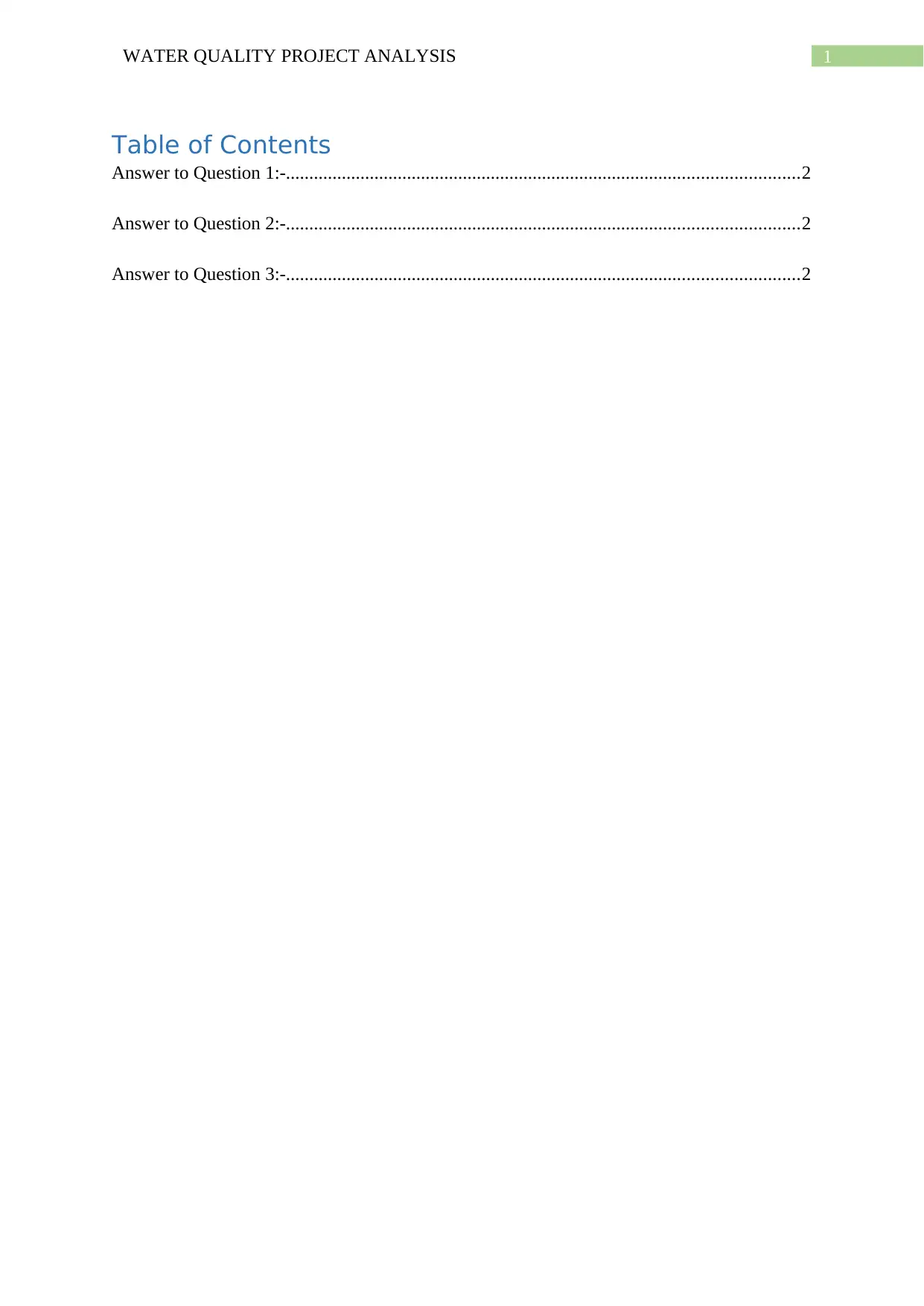
1WATER QUALITY PROJECT ANALYSIS
Table of Contents
Answer to Question 1:-..............................................................................................................2
Answer to Question 2:-..............................................................................................................2
Answer to Question 3:-..............................................................................................................2
Table of Contents
Answer to Question 1:-..............................................................................................................2
Answer to Question 2:-..............................................................................................................2
Answer to Question 3:-..............................................................................................................2
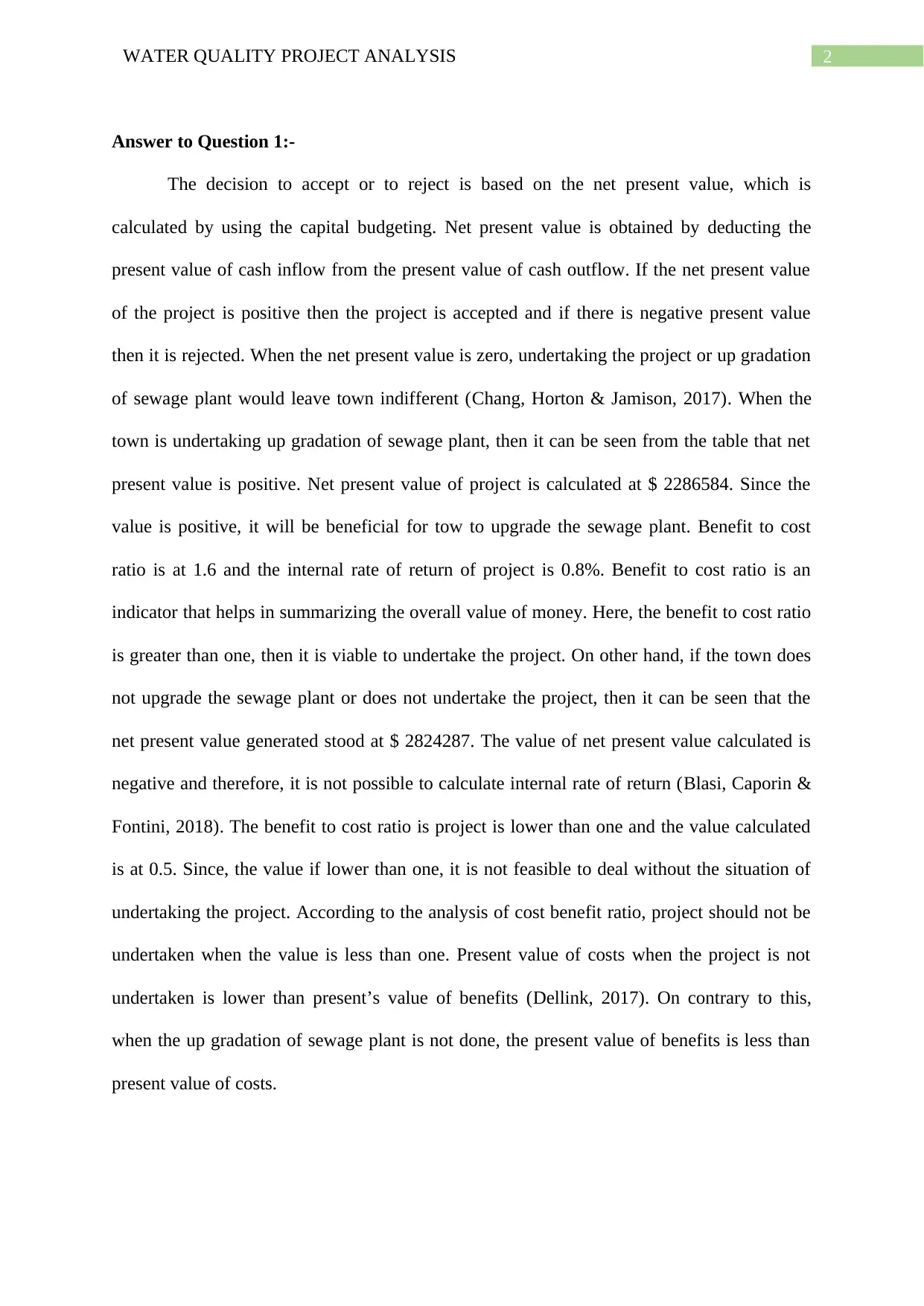
2WATER QUALITY PROJECT ANALYSIS
Answer to Question 1:-
The decision to accept or to reject is based on the net present value, which is
calculated by using the capital budgeting. Net present value is obtained by deducting the
present value of cash inflow from the present value of cash outflow. If the net present value
of the project is positive then the project is accepted and if there is negative present value
then it is rejected. When the net present value is zero, undertaking the project or up gradation
of sewage plant would leave town indifferent (Chang, Horton & Jamison, 2017). When the
town is undertaking up gradation of sewage plant, then it can be seen from the table that net
present value is positive. Net present value of project is calculated at $ 2286584. Since the
value is positive, it will be beneficial for tow to upgrade the sewage plant. Benefit to cost
ratio is at 1.6 and the internal rate of return of project is 0.8%. Benefit to cost ratio is an
indicator that helps in summarizing the overall value of money. Here, the benefit to cost ratio
is greater than one, then it is viable to undertake the project. On other hand, if the town does
not upgrade the sewage plant or does not undertake the project, then it can be seen that the
net present value generated stood at $ 2824287. The value of net present value calculated is
negative and therefore, it is not possible to calculate internal rate of return (Blasi, Caporin &
Fontini, 2018). The benefit to cost ratio is project is lower than one and the value calculated
is at 0.5. Since, the value if lower than one, it is not feasible to deal without the situation of
undertaking the project. According to the analysis of cost benefit ratio, project should not be
undertaken when the value is less than one. Present value of costs when the project is not
undertaken is lower than present’s value of benefits (Dellink, 2017). On contrary to this,
when the up gradation of sewage plant is not done, the present value of benefits is less than
present value of costs.
Answer to Question 1:-
The decision to accept or to reject is based on the net present value, which is
calculated by using the capital budgeting. Net present value is obtained by deducting the
present value of cash inflow from the present value of cash outflow. If the net present value
of the project is positive then the project is accepted and if there is negative present value
then it is rejected. When the net present value is zero, undertaking the project or up gradation
of sewage plant would leave town indifferent (Chang, Horton & Jamison, 2017). When the
town is undertaking up gradation of sewage plant, then it can be seen from the table that net
present value is positive. Net present value of project is calculated at $ 2286584. Since the
value is positive, it will be beneficial for tow to upgrade the sewage plant. Benefit to cost
ratio is at 1.6 and the internal rate of return of project is 0.8%. Benefit to cost ratio is an
indicator that helps in summarizing the overall value of money. Here, the benefit to cost ratio
is greater than one, then it is viable to undertake the project. On other hand, if the town does
not upgrade the sewage plant or does not undertake the project, then it can be seen that the
net present value generated stood at $ 2824287. The value of net present value calculated is
negative and therefore, it is not possible to calculate internal rate of return (Blasi, Caporin &
Fontini, 2018). The benefit to cost ratio is project is lower than one and the value calculated
is at 0.5. Since, the value if lower than one, it is not feasible to deal without the situation of
undertaking the project. According to the analysis of cost benefit ratio, project should not be
undertaken when the value is less than one. Present value of costs when the project is not
undertaken is lower than present’s value of benefits (Dellink, 2017). On contrary to this,
when the up gradation of sewage plant is not done, the present value of benefits is less than
present value of costs.
⊘ This is a preview!⊘
Do you want full access?
Subscribe today to unlock all pages.

Trusted by 1+ million students worldwide

3WATER QUALITY PROJECT ANALYSIS
Answer to Question 2:-
The acceptation of up gradation project of sewage is also depends on the net present
value of the project, which is calculated by using the capital budgeting technique.
The above table shows the various factors that is deals with the calculation of net
present value. Now, if the project is not undertaken, then it can be observed that the total
negative benefits stood at $2319900. When the project is not undertaken, total positive
benefits attributable to costs stands at $ 632125902. It can be seen from the figures that town
would be benefitted on overall basis if the project of upgrading sewage is undertaken by
town. Now, dividing each factors costs and benefits, it can be seen that benefits from
producing lettuce will be more when the project is undertaken compared when the project is
not undertaken. Industry will be negatively impacted initially that leads to increasing costs
along with agriculture resulting from degradation of water of river. However, in case when
the project is not undertaken, the benefits attributable from industry and agriculture will be
zero (Bennett & James, 2017). Now, looking at health, it can be seen that health of population
of town would be negatively impacted. Undertaking the project will have many benefits to
the fishery areas as no additional capital is required for operating the fishing department. It
requires only operating and maintenance costs. When the project is not undertaken, there are
no benefits attributable from fishing areas. With project undertaken, the benefits that would
arise from fisheries is estimated at $ 634064743. Thus is the highest amount of benefits that
Answer to Question 2:-
The acceptation of up gradation project of sewage is also depends on the net present
value of the project, which is calculated by using the capital budgeting technique.
The above table shows the various factors that is deals with the calculation of net
present value. Now, if the project is not undertaken, then it can be observed that the total
negative benefits stood at $2319900. When the project is not undertaken, total positive
benefits attributable to costs stands at $ 632125902. It can be seen from the figures that town
would be benefitted on overall basis if the project of upgrading sewage is undertaken by
town. Now, dividing each factors costs and benefits, it can be seen that benefits from
producing lettuce will be more when the project is undertaken compared when the project is
not undertaken. Industry will be negatively impacted initially that leads to increasing costs
along with agriculture resulting from degradation of water of river. However, in case when
the project is not undertaken, the benefits attributable from industry and agriculture will be
zero (Bennett & James, 2017). Now, looking at health, it can be seen that health of population
of town would be negatively impacted. Undertaking the project will have many benefits to
the fishery areas as no additional capital is required for operating the fishing department. It
requires only operating and maintenance costs. When the project is not undertaken, there are
no benefits attributable from fishing areas. With project undertaken, the benefits that would
arise from fisheries is estimated at $ 634064743. Thus is the highest amount of benefits that
Paraphrase This Document
Need a fresh take? Get an instant paraphrase of this document with our AI Paraphraser
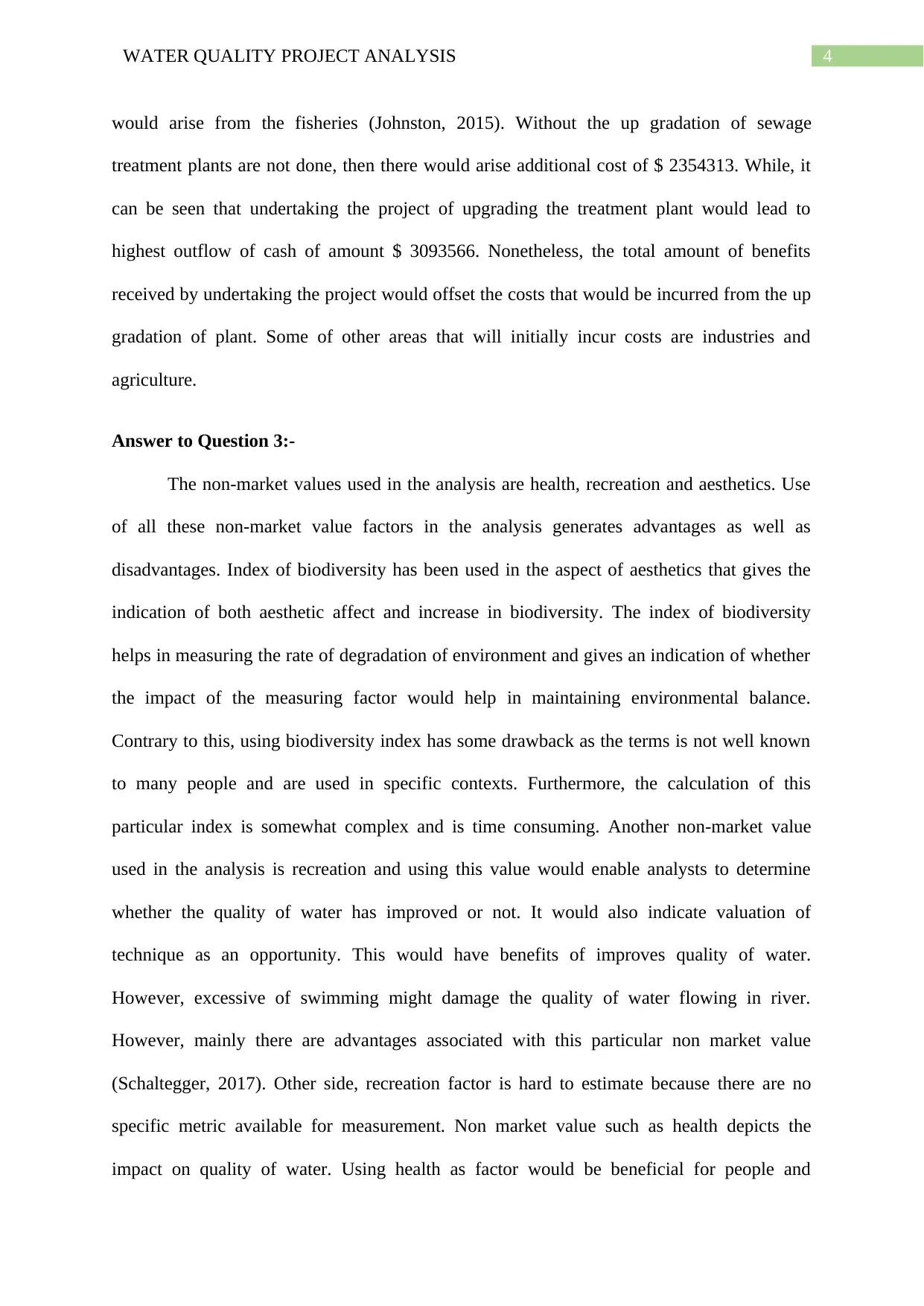
4WATER QUALITY PROJECT ANALYSIS
would arise from the fisheries (Johnston, 2015). Without the up gradation of sewage
treatment plants are not done, then there would arise additional cost of $ 2354313. While, it
can be seen that undertaking the project of upgrading the treatment plant would lead to
highest outflow of cash of amount $ 3093566. Nonetheless, the total amount of benefits
received by undertaking the project would offset the costs that would be incurred from the up
gradation of plant. Some of other areas that will initially incur costs are industries and
agriculture.
Answer to Question 3:-
The non-market values used in the analysis are health, recreation and aesthetics. Use
of all these non-market value factors in the analysis generates advantages as well as
disadvantages. Index of biodiversity has been used in the aspect of aesthetics that gives the
indication of both aesthetic affect and increase in biodiversity. The index of biodiversity
helps in measuring the rate of degradation of environment and gives an indication of whether
the impact of the measuring factor would help in maintaining environmental balance.
Contrary to this, using biodiversity index has some drawback as the terms is not well known
to many people and are used in specific contexts. Furthermore, the calculation of this
particular index is somewhat complex and is time consuming. Another non-market value
used in the analysis is recreation and using this value would enable analysts to determine
whether the quality of water has improved or not. It would also indicate valuation of
technique as an opportunity. This would have benefits of improves quality of water.
However, excessive of swimming might damage the quality of water flowing in river.
However, mainly there are advantages associated with this particular non market value
(Schaltegger, 2017). Other side, recreation factor is hard to estimate because there are no
specific metric available for measurement. Non market value such as health depicts the
impact on quality of water. Using health as factor would be beneficial for people and
would arise from the fisheries (Johnston, 2015). Without the up gradation of sewage
treatment plants are not done, then there would arise additional cost of $ 2354313. While, it
can be seen that undertaking the project of upgrading the treatment plant would lead to
highest outflow of cash of amount $ 3093566. Nonetheless, the total amount of benefits
received by undertaking the project would offset the costs that would be incurred from the up
gradation of plant. Some of other areas that will initially incur costs are industries and
agriculture.
Answer to Question 3:-
The non-market values used in the analysis are health, recreation and aesthetics. Use
of all these non-market value factors in the analysis generates advantages as well as
disadvantages. Index of biodiversity has been used in the aspect of aesthetics that gives the
indication of both aesthetic affect and increase in biodiversity. The index of biodiversity
helps in measuring the rate of degradation of environment and gives an indication of whether
the impact of the measuring factor would help in maintaining environmental balance.
Contrary to this, using biodiversity index has some drawback as the terms is not well known
to many people and are used in specific contexts. Furthermore, the calculation of this
particular index is somewhat complex and is time consuming. Another non-market value
used in the analysis is recreation and using this value would enable analysts to determine
whether the quality of water has improved or not. It would also indicate valuation of
technique as an opportunity. This would have benefits of improves quality of water.
However, excessive of swimming might damage the quality of water flowing in river.
However, mainly there are advantages associated with this particular non market value
(Schaltegger, 2017). Other side, recreation factor is hard to estimate because there are no
specific metric available for measurement. Non market value such as health depicts the
impact on quality of water. Using health as factor would be beneficial for people and
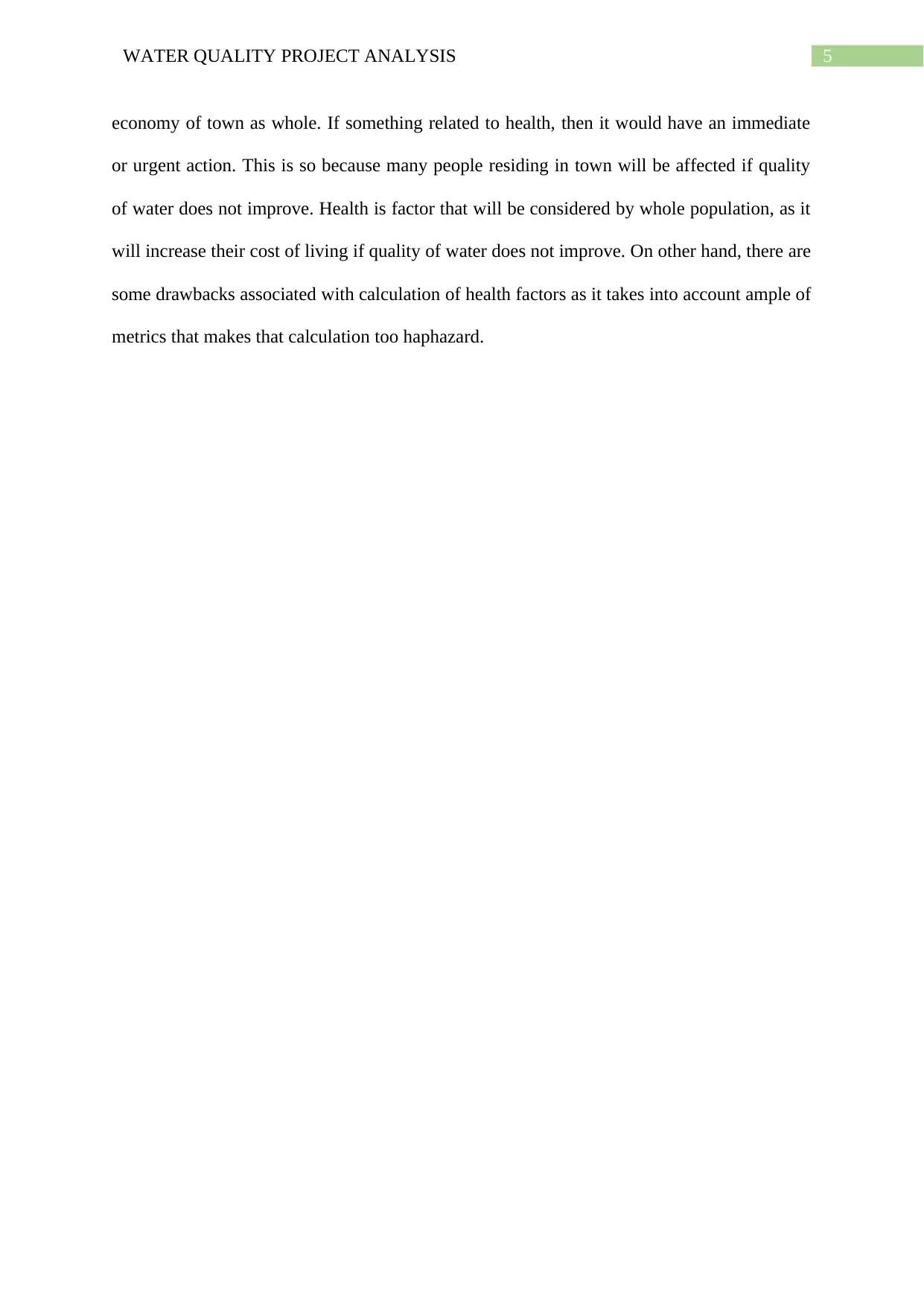
5WATER QUALITY PROJECT ANALYSIS
economy of town as whole. If something related to health, then it would have an immediate
or urgent action. This is so because many people residing in town will be affected if quality
of water does not improve. Health is factor that will be considered by whole population, as it
will increase their cost of living if quality of water does not improve. On other hand, there are
some drawbacks associated with calculation of health factors as it takes into account ample of
metrics that makes that calculation too haphazard.
economy of town as whole. If something related to health, then it would have an immediate
or urgent action. This is so because many people residing in town will be affected if quality
of water does not improve. Health is factor that will be considered by whole population, as it
will increase their cost of living if quality of water does not improve. On other hand, there are
some drawbacks associated with calculation of health factors as it takes into account ample of
metrics that makes that calculation too haphazard.
⊘ This is a preview!⊘
Do you want full access?
Subscribe today to unlock all pages.

Trusted by 1+ million students worldwide
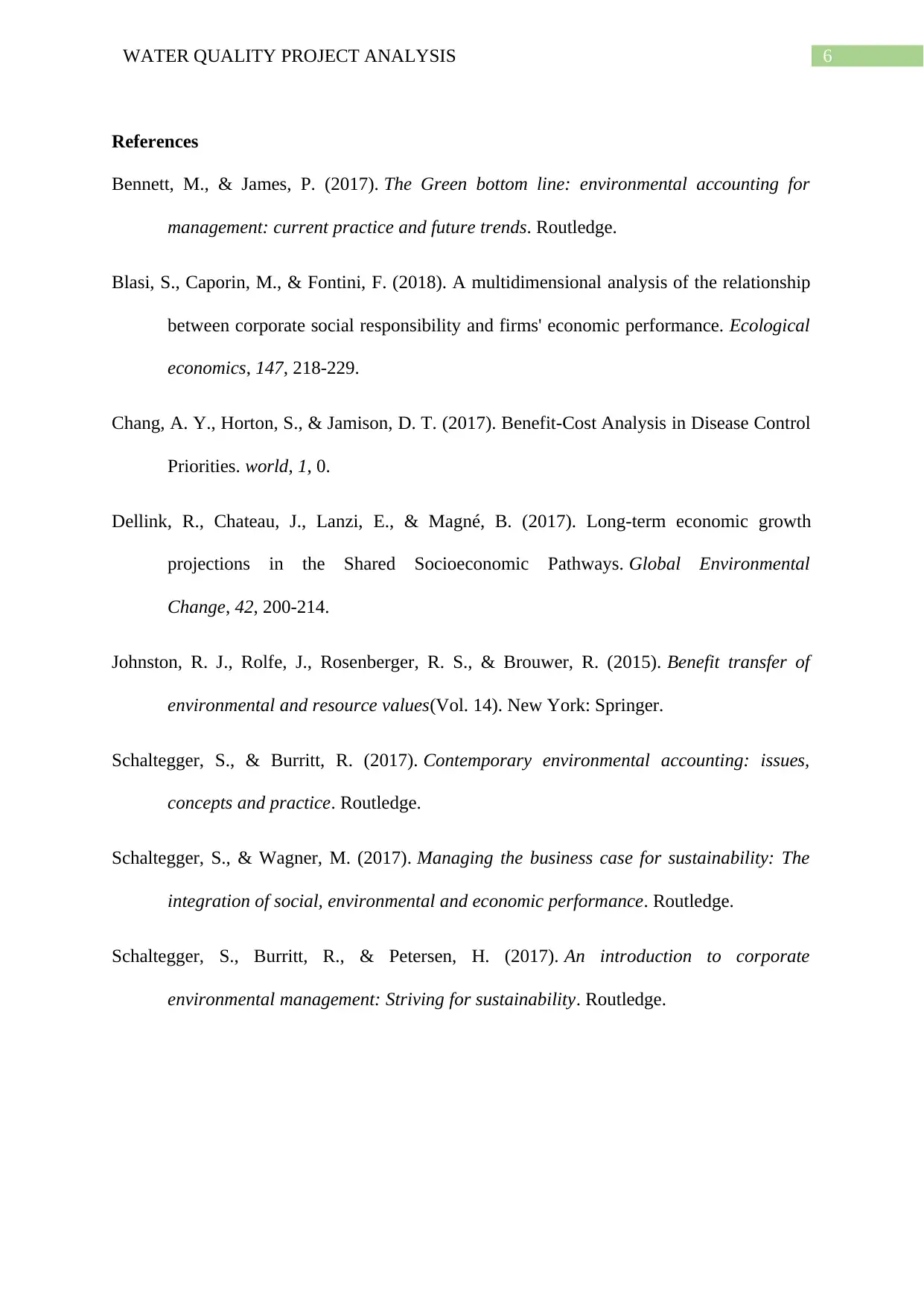
6WATER QUALITY PROJECT ANALYSIS
References
Bennett, M., & James, P. (2017). The Green bottom line: environmental accounting for
management: current practice and future trends. Routledge.
Blasi, S., Caporin, M., & Fontini, F. (2018). A multidimensional analysis of the relationship
between corporate social responsibility and firms' economic performance. Ecological
economics, 147, 218-229.
Chang, A. Y., Horton, S., & Jamison, D. T. (2017). Benefit-Cost Analysis in Disease Control
Priorities. world, 1, 0.
Dellink, R., Chateau, J., Lanzi, E., & Magné, B. (2017). Long-term economic growth
projections in the Shared Socioeconomic Pathways. Global Environmental
Change, 42, 200-214.
Johnston, R. J., Rolfe, J., Rosenberger, R. S., & Brouwer, R. (2015). Benefit transfer of
environmental and resource values(Vol. 14). New York: Springer.
Schaltegger, S., & Burritt, R. (2017). Contemporary environmental accounting: issues,
concepts and practice. Routledge.
Schaltegger, S., & Wagner, M. (2017). Managing the business case for sustainability: The
integration of social, environmental and economic performance. Routledge.
Schaltegger, S., Burritt, R., & Petersen, H. (2017). An introduction to corporate
environmental management: Striving for sustainability. Routledge.
References
Bennett, M., & James, P. (2017). The Green bottom line: environmental accounting for
management: current practice and future trends. Routledge.
Blasi, S., Caporin, M., & Fontini, F. (2018). A multidimensional analysis of the relationship
between corporate social responsibility and firms' economic performance. Ecological
economics, 147, 218-229.
Chang, A. Y., Horton, S., & Jamison, D. T. (2017). Benefit-Cost Analysis in Disease Control
Priorities. world, 1, 0.
Dellink, R., Chateau, J., Lanzi, E., & Magné, B. (2017). Long-term economic growth
projections in the Shared Socioeconomic Pathways. Global Environmental
Change, 42, 200-214.
Johnston, R. J., Rolfe, J., Rosenberger, R. S., & Brouwer, R. (2015). Benefit transfer of
environmental and resource values(Vol. 14). New York: Springer.
Schaltegger, S., & Burritt, R. (2017). Contemporary environmental accounting: issues,
concepts and practice. Routledge.
Schaltegger, S., & Wagner, M. (2017). Managing the business case for sustainability: The
integration of social, environmental and economic performance. Routledge.
Schaltegger, S., Burritt, R., & Petersen, H. (2017). An introduction to corporate
environmental management: Striving for sustainability. Routledge.
1 out of 7
Related Documents
Your All-in-One AI-Powered Toolkit for Academic Success.
+13062052269
info@desklib.com
Available 24*7 on WhatsApp / Email
![[object Object]](/_next/static/media/star-bottom.7253800d.svg)
Unlock your academic potential
© 2024 | Zucol Services PVT LTD | All rights reserved.





